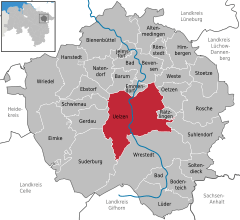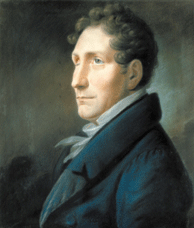Uelzen
| Uelzen | ||
|---|---|---|
|
| ||
| ||
 Uelzen | ||
Location of Uelzen within Uelzen district 
 | ||
| Coordinates: 52°57′53″N 10°33′57″E / 52.96472°N 10.56583°ECoordinates: 52°57′53″N 10°33′57″E / 52.96472°N 10.56583°E | ||
| Country | Germany | |
| State | Lower Saxony | |
| District | Uelzen | |
| Government | ||
| • Mayor | Jens Markwardt (Ind.) | |
| Area | ||
| • Total | 135.84 km2 (52.45 sq mi) | |
| Population (2015-12-31)[1] | ||
| • Total | 33,782 | |
| • Density | 250/km2 (640/sq mi) | |
| Time zone | CET/CEST (UTC+1/+2) | |
| Postal codes | 29525 | |
| Dialling codes | 0581 | |
| Vehicle registration | UE | |
| Website | www.uelzen.de | |
Uelzen (officially the Hanseatic Town of Uelzen, German: Hansestadt Uelzen, German pronunciation: [ˈʔʏltsən], Low German Ülz’n[2]) is a town in northeast Lower Saxony, Germany, and capital of the county of Uelzen. It is part of the Hamburg Metropolitan Region, a Hanseatic town and an independent municipality.
Uelzen is characterised by timber-framed architecture and also has some striking examples of North German brick Gothic. But the county town earned pan-regional fame when Friedensreich Hundertwasser was selected to redesign the station. The final work of the celebrated Viennese artist and architect was ceremonially opened in 2000 as the Hundertwasser Station, Uelzen and has since been a popular tourist magnet.
The Polabian name for Uelzen is Wilcaus (spelled Wiltzaus in older German reference material), possibly derived from wilca or wilsa (< Slavic *olăša) 'alder'.
Geography
Location
Uelzen lies on the edge of the Lüneburg Heath. The town is a transport hub on the north-south axis from Hamburg to Hanover as well as the east-west axis from Bremen to Berlin. Also of economic importance is its location on the Elbe Lateral Canal. The town's has a charming setting, situated as it is on the heath river, the Ilmenau, with its grassy river banks, small parks and water meadows. Large areas in the vicinity of Uelzen have been set aside as nature parks with moors, woods, lakes and heathland: the Elbhöhen-Wendland Nature Park, Lüneburg Heath Nature Park and Lower Saxon Elbe Valley Water Meadows Biosphere Reserve.
Divisions
The following parishes belong to the borough of Uelzen: Groß Liedern, Halligdorf, Hambrock, Hansen, Hanstedt II, Holdenstedt, Kirchweyhe, Klein Süstedt, Masendorf, Mehre, Molzen, Oldenstadt, Riestedt, Ripdorf, Tatern, Veerßen, Westerweyhe and Woltersburg.
Furthermore, there are four other places that have the status of "special parishes" (Sonstige Ortsteile): Borne, Kl. Liedern, Pieperhöfen and Oldenstadt-West.
Neighbouring towns
| Buchholz in der Nordheide 80 km |
Lüneburg, Hamburg 37 km, 92 km |
Dannenberg 41 km | |
| Munster, Soltau 37 km, 56 km |
|
Lüchow 43 km | |
| |||
| | |||
| Celle, Hanover 54 km, 95 km |
Gifhorn, Wolfsburg 58 km, 82 km |
Wittingen, Salzwedel 31 km, 45 km |
History
.jpg)
The town was founded about 1250. In 1270 Duke John of Brunswick-Lüneburg, a Welf who ruled the Principality of Lüneburg from 1252 to 1277, granted Uelzen its town privileges (Stadtrechte).[3] In the Middle Ages became an active member of the Hanseatic League.[4] The town fortification, built in the 14th century, originally had 3 gates, a wall and a moat. Parts of the wall are still standing.
While Uelzen only played a small role in the Hanseatic League, there is evidence that it traded with Livonia and Spain. "At the Schnellenmarket, a London trading office purchased Uelzener linen, earthenware pitchers were offered for sale and brewery business flourished. On 21 October 1470, Uelzen was the venue for a Hanseatic League Convention. A special honour as these resolutions of the association of cities only took place annually - primarily in Lübeck."[5]
The town became part of the Electorate of Hanover in 1708, the Kingdom of Westphalia in 1807, the Kingdom of Hanover in 1814, and the Prussian Province of Hanover in 1866.
Uelzen was the site of a Nazi concentration camp which was established in Uelzen until 17 April 1945. The camp was a subcamp of the Neuengamme concentration camp.[6]
Governance

Uelzen belongs to the Bundestag constituency of Celle-Uelzen. In 2009 Henning Otte (CDU) was directly elected, having been on the state list (place 19) since 2005. Kirsten Lühmann (SPD) was elected in 2009 via the state list. In the years 1998, 2002 and 2005 Peter Struck (SPD), former defence minister and chairman of the SPD party in the German Bundestag, was directly elected.
Mayor
The mayor of Uelzen since 2014 is Jens Markwardt (independent). In the 2014 election he was confirmed in office with 64.4% of the vote. The deputy mayors are Karsten Jäkel (CDU) und Ariane Schmäschke (The Greens).
- 1913–1946: Johann Maria Farina
- 1946: Dr. Heinz Lücke (CDU)
- 1946–1948: Adolf Hochgraefe (SPD)
- 1948–1950: Dr. Heinz Lücke
- 1950–1952: Adolf Hochgraefe
- 1952–1961: Dr. Heinz Lücke
- 1961–1963: Adolf Hochgraefe
- 1963–1964: Dr. Heinz Lücke
- 1964–1972: Alfred Krüger (CDU)
- 1972–1979: Rudi Schrödter (SPD)
- 1979–1981: Hans-Alexander Drechsler (SPD)
- 1981–1991: Rudolf Froin (CDU)
- 1991–1997: Günter Leifert (SPD)
- 1997–2001: Günter Leifert (hauptamtlich)
- 2001–2014: Otto Lukat (SPD)
- 2014: Jürgen Markwardt (independent)
Town twinning
Uelzen is twinned with:
-
 21 municipalities in the north and east of Rouen, France
21 municipalities in the north and east of Rouen, France -
 Barnstaple, United Kingdom
Barnstaple, United Kingdom -
 Tikaré, Burkina Faso
Tikaré, Burkina Faso -
 Kobryn, Belarus
Kobryn, Belarus
Arts and culture

Theatre
The number of cultural offerings is large and varied given the size of the city. The multitude of cinemas, the theatre on the Ilmenau (Theater an der Ilmenau), the Jabelmann Events Hall and the fringe theatre on the Rosenmauer are some of Uelzens attractions.
Museums
Worthy of mention is the Holdenstedt Castle Museum (Museum Schloss Holdenstedt) which is the town's local history museum. Permanent exhibitions include furniture from the Middle Ages to art nouveau, a glass collection, works by the animal painter, Georg Wolf, and archaeological finds from the local area.
Economy
The largest sugarbeet refinery in the Nordzucker group is in Uelzen. It processes approximately 20,000 tons of sugarbeet per day. Further big employers in the town are Nestlé Schöller or the dairy Uelzena.
Infrastructure
Railway station
The Hundertwasserbahnhof is a railway station in Uelzen at the eastern edge of the Lüneburg Heath Nature Park in northeastern Lower Saxony. The cities within easy reach by rail are Hamburg, Hannover, Lüneburg, Celle, Braunschweig, Bremen and Berlin.
The original station was renovated for Expo 2000 following plans by the Austrian artist and architect Friedensreich Hundertwasser. An "environmentally, culturally oriented" station, Uelzen station was renamed as 'Hundertwasser Station, Uelzen' (Hundertwasser-Bahnhof Uelzen). Today it is one of the town's popular tourist attractions.
Courts
Uelzen has at its disposal an Amtsgericht (roughly, a district court), which belongs to the state court region of Lüneburg and the Oberlandesgericht (High State Court) region of Celle.
Education
Schools in Uelzen include the Herzog-Ernst-Gymnasium, Lessing-Gymnasium, Oberschule-Uelzen, Lucas-Backmeister-Schule, Sternschule, Berufsbildene Schulen I and II and 6 elementary schools.
Health and medicine
Uelzen has one hospital (HELIOS Klinikum), two clinics that specialises in different areas (Klinik Veerßen and Psychiatrische Klinik Uelzen) and some pharmacies and dentists.
Sons and daughters of the town
- Mola Adebisi (born 1973), former TV presenter (VIVA)
- Rebecca Harms (born 1956 in Hambrock), politician (The Greens)
- Theodore Kaufmann (1814–1896) (Theodor Kaufmann ), German-born American painter

- Friedrich Kuhlau (1786–1832), court composer to the Danish royal court
- Angelika Volquartz (born 1946), politician (CDU), 2003-2009 Mayor of Kiel
- Walter Wallmann (1932–2013), politician (CDU), among others, Minister for the Environment, Nature Conservation and Nuclear Safety and Minister President of Hessen
- Georg Wilding (1790–1841), royal-Neapolitan envoy in St. Petersburg
- Eberhard August Wilhelm von Zimmermann (1743–1815), geographer and biologist
See also
Notes
- ↑ Landesbetrieb für Statistik und Kommunikationstechnologie Niedersachsen, 102 Bevölkerung - Basis Zensus 2011, Stand 31. Dezember 2015 (Tabelle K1020014)
- ↑ Eduard Kück: Lüneburger Wörterbuch. Wortschatz der Lüneburger Heide und ihrer Randgebiete, seit 1900 zusammen mit vielen Mitarbeitern gesammelt und sprachwissenschaftlich sowie volkskundlich erläutert von Professor Dr. Eduard Kück. Dritter Band: S–Z. Neumünster: Karl Wachholtz 1967
- ↑ http://www.hanse.org/en/hanseatic-cities/uelzen-tourism
- ↑
 Chisholm, Hugh, ed. (1911). "Uelzen". Encyclopædia Britannica. 27 (11th ed.). Cambridge University Press. p. 556.
Chisholm, Hugh, ed. (1911). "Uelzen". Encyclopædia Britannica. 27 (11th ed.). Cambridge University Press. p. 556. - ↑ http://www.hanse.org/en/hanseatic-cities/uelzen.php
- ↑ The camp is listed as No. 1491 Uelzen in the official German list.
References
- Official German list of concentration camps Verzeichnis der Konzentrationslager und ihrer Außenkommandos (German)
- Johann Parum Schultze; Reinhold Olesch (Hrsg.): Fontes linguae Dravaenopolabicae minores et Chronica Venedica J. P. Schultzii. (= Slavistische Forschungen; Band 7). Böhlau, Köln und Graz 1967
- Christian Hennig von Jessen: Vocabularium Venedicum (oder Wendisches Wörter-Buch) (1705). Nachdruck besorgt von Reinhold Olesch. - Köln [u.a.]: Böhlau 1959 (Gewährsmann des Pastors C. Hennig von Jessen war der polabisch sprechende Bauer Johann Janieschge aus Klennow)
External links
| Wikimedia Commons has media related to Uelzen. |
| Wikivoyage has a travel guide for Uelzen. |
- Official site (German)
- Uelzen website translated to English with google translation
-
 "Uelzen". Encyclopædia Britannica (11th ed.). 1911.
"Uelzen". Encyclopædia Britannica (11th ed.). 1911.

